#binary arithmetics
Text
youtube
Russian Multiplication - Numberphile
0 notes
Text
A Brief Overview Of Binary Calculator: What Are The Basic Binary Operations?

If you talk about a Binary number, it is a number expressed as the base 2 of the numeral system. The binary number system uses two numbers, 0 and 1. The binary number system has positional notation as a radix with a base of 2. A bit is called a single binary digit.
These days, like all computers, use the binary system so you can use All Calculator.net's Binary Calculator. For example, a decimal is six and can be expressed as 110. Like arithmetic operations, binary operations consist of subtraction, addition, division and multiplication.
What are the basic Arithmetic Binary operations?
Commonly, binary numbers are known as numbers with a base of 2. It includes only two digits, such as 0 and 1. These digits of 0 and 1 are called the thread of bits which indicate the two logic states as 'on' and 'off'. Binary numbers can convert into decimal numbers and back and forth. There are mainly four arithmetic operations in the binary system:
Binary Addition: The core base of All Calculator.net's Binary Calculator is a binary addition. It works the same as a decimal addition. It has four key rules 0+0 = 0, 0+1 = 1, 1+0 =1 and 1+1 = 0, carrying 1 to the next bit.
Binary Subtraction: It executes in two ways, like the complement method wherein you have to replace subtrahend with the two complements and performs a binary addition. The other way is the 'borrow method', similar to the decimal subtraction procedure.
Binary Multiplication: It is the same as long decimal multiplication based on binary addition. It has four main rules like 0*0 = 0, 0*1 = 0, 1*0 = 0 and 1*1 = 1.
Binary division: It follows the process of long decimal division. The binary division includes binary subtraction and multiplication steps. Beginning from the left, it is performed once the dividends digit divides with the divisor.
You can perform the calculations using All Calculator.net's Binary Calculator to get accurate and error-free results. It provides you with correct outputs in a fraction of a second. Use it today and see the difference!
0 notes
Text
Every now and then I remember that Malbolge exists and I get to spend the better part of an hour cry-laughing at the world’s worst programming language

already starting off strong, but it gets worse
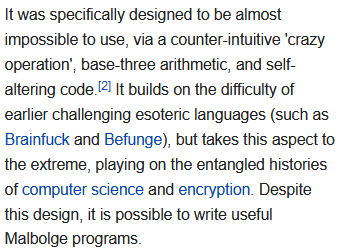
Wow! Sounds easy and intuitive to use! What’s the “crazy operation” you ask? We’ll get to that later. For now let’s see what a program in this language looks like :)

Thanks! I hate it!

it’s so difficult to work with that the first program was written by another brute force search program

mmmmm delicious base-3 arithmetic, what could go wrong? (For reference, that means this program forgoes the usual “0/1″ values of binary code in favor of a much more fun “0/1/2″ set of values)

ah.
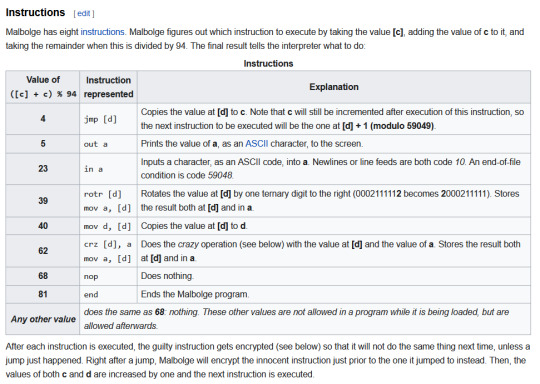
Here’s how the language actually figures out what to do. It’s got 8 “simple” commands that can be executed easily by *checks notes* running the code itself through the modulo operation and taking the result.

As a bonus, on top of all that every single character in your code will now alter what every single other character does. So I hope you’re alright with cracking a cipher every time you add a new letter to your program!

oh god oh fuck.

behold, Malbolge’s primary arithmetic operation and what you’ll be using for most of your math while programming with it :)
This looks specifically designed to be the least logical math operation you could make, and knowing what the rest of Malbolge is I’d wager that’s precisely what happened. I never want to ever use this and it’s my favorite thing I’ve ever seen.
https://en.wikipedia.org/wiki/Malbolge
Anyways here’s the wiki page if you wanna read through it more deeply, I’m gonna sit here holding in my laughter staring at the hello world program again.
#malbolge#esoteric programming#programming#crazy operation#computer science#esoteric programming language#programming languages#lavender speaks
12K notes
·
View notes
Text
This came across my dash via the #lgbt tag yesterday. I don't want to engage with the OP because that would get me into fights on radfem tumblr and I don't have the energy for that. But the post itself I think is worth answering, just because it's so neatly and exactly wrong.
(Not that my answer is going to spread very far, because I have 37 non-bot followers, of whom I think roughly 35.5 are just here for the nude photos. But anyway.)
Even if I agree just for argument's sake that the existence of intersex people proves that some people can have "nonbinary" sexes, or "third" sexes, and that "sex is a spectrum," how does that have any relevance to people who are not intersex? Like okay, let's "agree" for the moment that intersex people are something other than male or female. How does that make YOU, as a person who is not intersex, something other than male or female? Saying that intersex people's existence somehow makes sex "complicated" for you specifically is like saying that the issue of whether or not you can hear is "complicated" because some other people who are not you suffer from hearing loss or deafness. Like sorry but for 99% of the human population it is not "more complicated" than born with perfectly normal male genitalia = male and born with perfectly normal female genitalia = female, and chances are you fall into that 99%.
Sex is not a social construct or a nebulous enigma of a concept. It is not debatable and made up in the manner that gender is. You cannot philosophize about whether there are two sexes any more than you can philosophize about whether humans have two kidneys. Someone having a missing or malformed kidney or accessory kidneys does not change the fact that humans as a species have two kidneys. Humans are gonochoric just like nearly all other animal species on Earth.
Let's start with the arithmetic. If 99% people are of binary sex, that leaves 1% of people who aren't. There are approximately 8 billion humans on Earth. 1% of 8 billion is 80 million -- about sixteen times the population of my entire country. Even just the number of intersex Americans is something like two-thirds the population of my country. This is not a negligible number of people.
There's a deeper error here, one that goes to the root not just of this misunderstanding but of many. Biology is always complicated, at every scale and at every level of explanation. It's messy, it's fuzzy, and it's always bottom-up, never top-down. Everything biological is the way it is because it grew that way. Biology never does the same thing twice.
Why does it seem like it does? Because, of all the ways you can arrange the parts of a living body, only an astonishingly tiny fraction of them actually make a living body. Any genetic mutation that nudges an organism outside of that fraction dies out and doesn't get passed on. Embryonic development is a gruelling tight-rope walk over a vast pit of non-existence.
Now for most of the body's systems, evolution has only had to produce one arrangement that works and survives. There's not an alternative plumbing plan where the oesophagus goes to the lungs and the trachea to the stomach. But for the reproductive system, evolution has to allow for two arrangements that work and survive, and it has to grow them both from the same starter kit.
What it does, therefore, is grow a body plan that works with a continuum of possible arrangements that includes both of those two. Various other points on the continuum may or may not be capable of producing viable gametes, but they're all survivable.
What biology doesn't do -- what biology never ever does -- is run new products on a conveyor belt stamping them into shape with cookie-cutters. The only things made that way are artificial constructs.
#science#biology#sex determination#evolution#embryology#lgbt#intersex#transgender#nonbinary#essentialism#biological essentialism#essentialism is not biological#biology is not friendly to transphobes
167 notes
·
View notes
Note
what in the world is a lich vacuum tunnel skeleton computer? it sounds cool as hell
powerful necromancer commands an army of the undead. said undead can be given rudimentary commands. by organising multiple undead to pass, say, metal rods between each other, you can create simple logic gates - order two undead to pass along any rods they're given, and order the third to only pass along a rod if both undead pass a rod to them, then you've got an AND gate. knowing this, our humble lich retreats to a mountain and sets their minions to work. they raise a large army of skeletons, tunneling out a series of inter-connected circuits inside the stone, and stationing these skeletons along the entire length, at arms length from each other. at a command, metal rods are passed to the input skeletons, which immediately hand them forwards, and on and on, passing through successive skeleton logic gates, forming an arithmetic unit, which are then passed to the output skeletons, which present our lich with a numeric solution, in binary. such a system can be extended and expanded as much as necessary. to reduce the effect of air resistance on our speedy skeleton stick slingers, the lich seals off the tunnels and further employs some skeletons to work bellows to constantly pump out the air and create a partial vacuum.
see also the feudal chinese version with dessicated alien peasants as presented in three body problem, for calculating celestial and astronomical movements
61 notes
·
View notes
Text
i'm trying to get over my deep embarrassment about being So Bad At Math and let myself accept it and work on it and really think about it again—
which is hard! because every time i even bring up my struggles and/or the idea of having dyscalculia i get shut down like "no you're too smart, you can do math, you're just anxious, you're just overthinking it"
... yeah, i can do math, but i do it slowly and by shortcuts and memorization and being good with calculators and by redoing everything five times as fast as i can to catch the inevitable stupid mistakes. i can do math like the average dyslexic person can read.
i'm a cashier and i can't count people's change back to them using that subtraction(?) trick. i mess up too often.
i'm overthinking it because i keep having to relearn significant parts of multiplication and division every year or two.
—and, uh, anyway, and now that i'm thinking about it again after getting back into therapy and all that. working actively on self-acceptance. it just hit me that the number i have the most trouble with is 1.
like of course i didn't want to admit that. one. one! can you even explain to me what one is? probably not! it's too obvious! it's intuitive, right?
well. not for me.
1 is actually a very abstract number. when you're looking at stuff in the real world—counting beans, slicing pies, whatever—you're actually arbitrarily grouping billions of atoms and molecules into a "single" object. you're one person, but you're also trillions of cells.
i do fine with the real world, but not so well with abstract quantities. my intuition is concrete. in the real world you can't multiply things. that would violate the conservation of mass. you just move things around (or compare them to each other). and practically speaking you're always moving around lumps of stuff and an atom or a crumb here or there doesn't matter. 100 vs 99 is not a big deal. 1 vs 2 is. (sometimes i get very upset about fractions.)
i can't hold the idea of "one" as a pure quantity in my mind very well. i think of everything as a set. (i was very happy to encounter set theory in middle school. genuinely ecstatic.) i have to visualize 1 as something tangible, give it a shape. a dot. a circle. a square. the problem is, 1 is really small. either i'm picturing it as something big enough to have other stuff in it—too big—or as basically an empty set, which ends up resulting in a lot of errors because i treat it like 0.
i can think it more easily in binary sometimes—explicitly distinguishing between 1 and 0!—but that means a lot of repetition which i can't keep track of well enough for regular arithmetic. the repetition is worse for my working memory.
idk, it's late and i'm rambling. it's just. this is a disability i have. it's on my mind because i've been struggling really badly with time management and today i really realized that a big part of that is because time management involves constantly doing math. i get to see my little arithmetic mistakes add up to cascading problems in real time.
what's a little 1 misplaced here or there? whoops, that 1 was an hour. 15 minutes is basically the same as 20. oh but 20 is about the same as 30. is there really a big difference between half an hour and an hour? well, i have 60 whole minutes, might as well waste 5. 45 minutes is almost an hour.
15 minutes late is "you no-call no-showed your appointment." 10 minutes late is "your timecard is looking bad. you're on your first warning, after your third one you're getting fired." 5 minutes late is a "tardy," and i've never had a clean attendance record.
it's past 3 a.m. i need to get up at 11. will i get 8 hours of sleep?
do i ever?
this is not a very kind world in which to struggle with simple math.
#dyscalculia#don't get me started on what it's like to manage money#at least you can't go into time debt#long post#venting#i guess#ableism
64 notes
·
View notes
Text
That stim toy is also a 'calculation rag' for some binary number stuff...
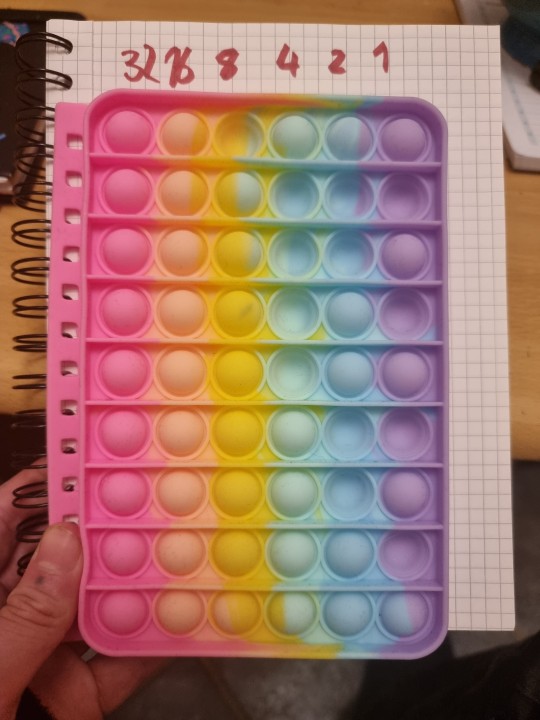
Everything can be used as a calculator...
... plus, this 'calculator rag' feels nice!
- - -- --- -----
... You can even turn it around and have a kind of invert thing.
hmm.. I wonder what sort of useless things I come up with as I add some transformation concepts in this calculator rag thingy.
----- --- -- - -
This stim toy might be a nice tool for explaining some binary number system stuff and arithmetics to people/children in a more playful, interactive and enjoyable way.
#this is the most perfect stim toy now: sensory yay PLUS mathy stuffy#math stuff#mathposting#stimtoy#neurodivergent#actually autistic#asd#autism#stim#stimming#mathy#math#math passion#calculation rag#in german it sounds eved funnier:#Kalkulationslappen#6x9#binary stuff#binary#maths#mathematics#calculator#interactive learning#binary arithmetics
228 notes
·
View notes
Text
More Speed, More Power, Pretty Pictures
I added some crude functions to the ROM monitor on my Wrap030 project to read the root directory of a FAT16-fomatted disk and load binary files into memory to execute. This opens up a new option for developing programs and running them on the computer, and makes it easier to keep programs on-hand for loading when I demonstrate the computer.
So what new program do I build first for running from disk? The same Mandelbrot renderer I've been using all along, of course! All I needed to do to get it running from disk was adjust a few load instructions to use PC-relative addressing and then change the vasm output to raw binary.
It ran without issue ... mostly. I had been noticing some instability with the system in general. It's not really related to the programming work I've been doing, it just tended to show itself more when doing the kind of FPU-intensive processing required for the Mandelbrot program. Sometimes the system wouldn't boot at all, sometimes it would continually reset. Other times it would run fine for a while, but randomly throw a coprocessor protocol exception (especially when using double- or extended-precision floating point values).
I had a pretty good idea of where this instability was coming from ...
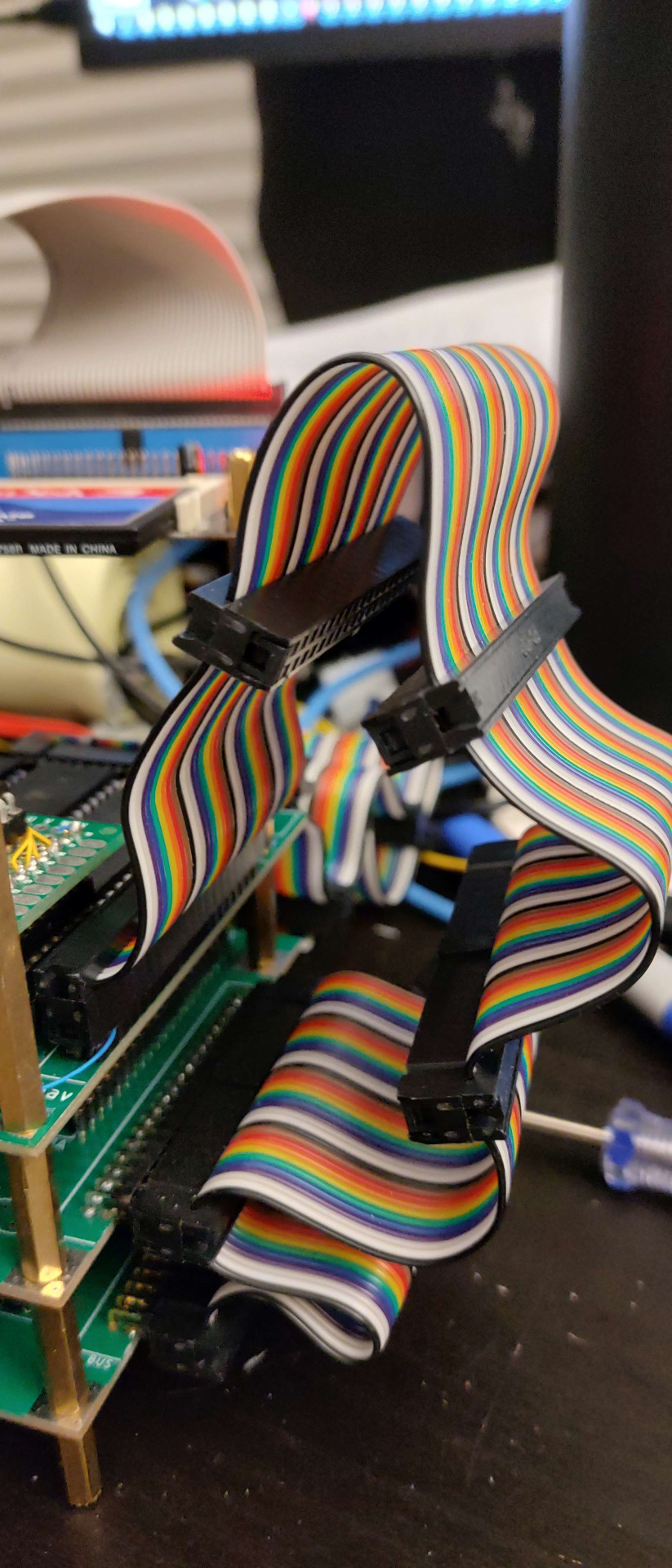
As someone on Discord put it, that's a pretty little antenna I've got there.
High speed computers don't like excessively-long wiring between components. I made the ribbon cables long because there were other boards I developed for this system. But, I'm only using the CPU board, the FPU + IDE mezzanine board, and the video generator board. All that extra wire is just making things more difficult.
A year ago, when I first put these three boards together, I had to bump the bus speed down to 25MHz to get it to run. I could run the CPU board up to 56MHz by itself, and I could get it to run with one expansion board or the other up to 40MHz, but with all three boards, 25MHz was the best I could do (out of the oscillators I had on hand). I have some 33MHz oscillators now, and while I could get it to run sometimes, it was obviously far more unstable.
It was time to trim those pretty little antennas.
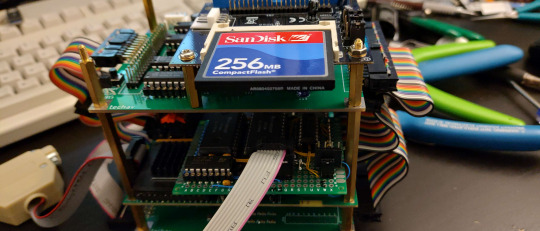
I left room for one more card, in case I can get my DRAM card working later, but trimmed a few inches off. The result? Rock solid at 25MHz now.
... and at 32MHz.
... but 40MHz still doesn't run.
I am quite pleased with that result. My target for this system in the beginning was 25MHz. That extra 30% speed increase is very noticeable, especially when running a program like the Mandelbrot renderer.
But I had a thought.
My FPU is rated for 25MHz, and here it's running solid at 32MHz along with the rest of the system. But my FPU board was designed to support the FPU running at a separate clock speed from the rest of the system (the 68881/68882 FPU is actually designed to support this, so I implemented it when I built my mezzanine board).
What would happen if I tried running the FPU even faster? Perhaps using that 40MHz oscillator that I couldn't use for the complete system?
Surprisingly, not a problem running the CPU at 32MHz and the FPU at 40MHz.
... or 50MHz
... or 55MHz
... or 67MHz!
Once again, I've run out of faster oscillators. This computer is running stable with its FPU clocked at over two and a half times its rated speed.
The video above is a real-time capture of the VGA output of this machine running that Mandelbrot renderer (now modified to use 96-bit extended-precision floating-point arithmetic!) with the CPU & main bus clocked at 32MHz and the FPU clocked at 67MHz. Some frames take minutes to render. Some complete in as little as seven seconds.
I am in awe. While I had big dreams when I first started working on this project six years ago, I never could have imagined it running this well at that kind of speed. I am very happy with how this project has turned out so far, and can't quite believe I actually built something like this.
I typically wrap up these posts with a plan of where to take the project next, but the project has already exceeded my expectations. There is so much it is already capable of now that I have a permanent storage option available. I guess I could try getting that DRAM card running to expand the main memory beyond 2MB, or try adding a keyboard and some text routines to complement the video card. Both are good options towards getting a proper operating system running, which has always been a goal of the project.
Either way, I'm sure I'll have fun with it.

#wrap030#mc68030#homebrew computing#retrocomputing#mandelbrot#motorola 68k#motorola 68030#homebrew computer#assembly programming#motorola 68882
18 notes
·
View notes
Text
Prime Numbers
A prime number is a number such that it has no factors except 1 and itself. These are often regarded as the building blocks of numbers, and are incredibly important from both:
a theoretical point of view, where problems such as the Riemann Hypothesis and Twin Prime conjecture revolve around the structure of primes
the application standpoint in music theory (Queen's famous song We Will Rock You has a beat that relies on prime numbers), and more relevantly, cryptography.

How do we get prime numbers
To say that a number x is a factor of another number y means that you can split y into equal groups, each group containing x things. So for example, if you wanted to divide 91 watermelons amongst your 13 friends, you can give them each 7 watermelons and everyone gets happy.
Another way of writing this is that 10 is a multiple of 2, or that 10 is divisible by 2.
With primes, you can't do this except by dividing them into groups of 1. For example, 2 is prime because you can only divide it into 2 equally sized groups. You can only divide 11 into 11 equally sized groups.
As a result, prime numbers have some very interesting properties, some of which are unknown. One very easy way to calculate them is by using the Sieve of Eratosthenes. The idea is that you start at 2 and remove every multiple of 2 except itself. So block out 4, 6, 8, 10, 12, and so on. Then you move onto the next unblocked number, which is 3. You go ahead and do the same, remove 6, 9, 12, 15, and so on. Notice that in the next step, 4 is blocked, so we go to 5, and block out 10, 15, 20, and so on. This process is very slow but it's certain. It tells you what the primes are with absolute certainty. Here's a picture to illustrate the idea. This excludes all the even numbers.
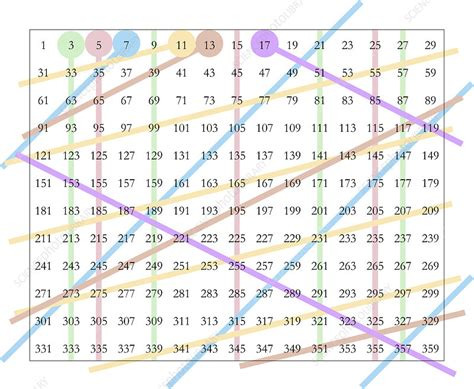
The atoms of natural numbers
Primes are regarded as the building blocks of numbers. This is due to the following theorem.
--------------
Fundamental Theorem of Arithmetic
Any integer n can be decomposed uniquely in products of powers of primes.
Examples
--------------
10 = 2 × 5
15 = 3 × 5
24 = 2³ × 3
There are many important theorems that come about due to primes, and almost all of them have to do with a topic called modular arithmetic.
Where to from here...
This is probably the extent to which you need to know about primes. Most of the ideas used will be introduced, as mentioned before, on an ad hoc basis. We will focus more on the code building aspects in our next parts, talking about binary and ISBN codes, before moving onto some more complicated examples of encrypting information.
46 notes
·
View notes
Text
via “Some disasters caused by numerical errors”:
On February 25, 1991, during the Gulf War, an American Patriot Missile battery in Dharan, Saudi Arabia, failed to track and intercept an incoming Iraqi Scud missile. The Scud struck an American Army barracks, killing 28 soldiers and injuring around 100 other people. A report of the General Accounting office, GAO/IMTEC-92-26, entitled Patriot Missile Defense: Software Problem Led to System Failure at Dhahran, Saudi Arabia reported on the cause of the failure. It turns out that the cause was an inaccurate calculation of the time since boot due to computer arithmetic errors. Specifically, the time in tenths of second as measured by the system's internal clock was multiplied by 1/10 to produce the time in seconds. This calculation was performed using a 24 bit fixed point register. In particular, the value 1/10, which has a non-terminating binary expansion, was chopped at 24 bits after the radix point. The small chopping error, when multiplied by the large number giving the time in tenths of a second, led to a significant error. Indeed, the Patriot battery had been up around 100 hours, and an easy calculation shows that the resulting time error due to the magnified chopping error was about 0.34 seconds.
(The number 1/10 equals
1/2⁴+1/2⁵+1/2⁸+1/2⁹+1/2¹²+1/2¹³+....
In other words, the binary expansion of 1/10 is
0.0001100110011001100110011001100....
Now the 24 bit register in the Patriot stored instead 0.00011001100110011001100 introducing an error of 0.0000000000000000000000011001100... binary, or about 0.000000095 decimal. Multiplying by the number of tenths of a second in 100 hours gives 0.000000095×100×60×60×10=0.34.)
A Scud travels at about 1,676 meters per second, and so travels more than half a kilometer in this time. This was far enough that the incoming Scud was outside the “range gate” that the Patriot tracked. Ironically, the fact that the bad time calculation had been improved in some parts of the code, but not all, contributed to the problem, since it meant that the inaccuracies did not cancel, as discussed here.
The following paragraph is excerpted from the GAO report.
The range gate's prediction of where the Scud will next appear is a function of the Scud's known velocity and the time of the last radar detection. Velocity is a real number that can be expressed as a whole number and a decimal (e.g., 3750.2563...miles per hour). Time is kept continuously by the system's internal clock in tenths of seconds but is expressed as an integer or whole number (e.g., 32, 33, 34...). The longer the system has been running, the larger the number representing time. To predict where the Scud will next appear, both time and velocity must be expressed as real numbers. Because of the way the Patriot computer performs its calculations and the fact that its registers are only 24 bits long, the conversion of time from an integer to a real number cannot be any more precise than 24 bits. This conversion results in a loss of precision causing a less accurate time calculation. The effect of this inaccuracy on the range gate's calculation is directly proportional to the target's velocity and the length of the the system has been running. Consequently, performing the conversion after the Patriot has been running continuously for extended periods causes the range gate to shift away from the center of the target, making it less likely that the target, in this case a Scud, will be successfully intercepted.
[x]
The March 13 issue of Science carried an article claiming, on the basis of a report from the General Accounting Office (GAO), that a “minute mathematical error … allowed an Iraqi Scud missile to slip
through Patriot missile defenses a year ago and hit U.S. Army barracks in Dhahran, Saudi Arabia, killing 28 servicemen.” The article continues with a readable account of what happened.
The article says that the computer doing the tracking calculations had an internal clock whose values were slightly truncated when converted to floating-point arithmetic. The errors were proportional to the time on the clock: 0.0275 seconds after eight hours and 0.3433 seconds after 100 hours. A calculation shows each of these relative errors to be both very nearly 2⁻²⁰, which is approximately 0.0001%.
The GAO report contains some additional information. The internal clock kept time as an integer value in units of tenths of a second, and the computer's registers were only 24 bits long. This and the consistency in the time lags suggested that the error was caused by a fixed-point 24-bit representation of 0.1 in base 2. The base 2 representation of 0.1 is nonterminating; for the first 23 binary digits after the binary point, the value is 0.1 × (1 - 2⁻²⁰). The use of 0.1 × (1 - 2⁻²⁰) in obtaining a floating-point value of time in seconds would cause all times to be reduced by 0.0001%.
This does not really explain the tracking errors, however, because the tracking of a missile should depend not on the absolute clock-time but rather on the time that elapsed between two different radar pulses. And because of the consistency of the errors, this time difference should be in error by only 0.0001%, a truly insignificant amount.
Further inquiries cleared up the mystery. It turns out that the hypothesis concerning the truncated binary representation of 0.1 was essentially correct. A 24-bit representation of 0.1 was used to multiply the clock-time, yielding a result in a pair of 24-bit registers. This was transformed into a 48-bit floating-point number. The software used had been written in assembly language 20 years ago. When Patriot systems were brought
into the Gulf conflict, the software was modified (several times) to cope with the high speed of ballistic missiles, for which the system was not originally designed.
At least one of these software modifications was the introduction of a subroutine for converting clock-time more accurately into floating-point. This calculation was needed in about half a dozen places in the program, but the call to the subroutine was not inserted at every point where it was needed. Hence, with a
less accurate truncated time of one radar pulse being subtracted from a more accurate time of another radar pulse, the error no longer cancelled.
In the case of the Dhahran Scud, the clock had run up a time of 100 hours, so the calculated elapsed time was too long by 2⁻²⁰ × 100 hours = 0.3433 seconds, during which time a Scud would be expected to travel more than half a kilometer.
The roundoff error, of course, is not the only problem that has been identified: serious doubts have been expressed about the ability of Patriot missiles to hit Scuds.
Robert Skeel is a professor of computer science at the University of Illinois at Urbana-Champaign.
From SIAM News, July 1992, Volume 25, Number 4, page 11
[x]
lmao
45 notes
·
View notes
Text
yall im totally going down a rabbit hole (researching wayyy past what i need to for the 4maxhalo cowboy AU im planning) but qsmpblr... did yall know binary code has existed since like, the 1500's? not quite as a code, from what i can tell (help me im literally reading some musty old pdf from 1981) but for math, in fact there is speculation it may have existed earlier. (help me i am reading an old math website from 2006 that obviously hasnt graced a screen in over a decade -__-) basically i thiink it was is that in egypt they used a shorthand (instead of modern day calculators lmao) to multiply larger numbers, for example 60X70, by dividing one number by two a bunch of times and doubling the other number the same amount of times.
so binary in computers comes from halving, mathematical roots.
there is another instance of direct language to a sort of binary substitution cipher, but instead of 1's and 0's it is A's and B's and random instead of following a pattern. this was first seen in the 1600's.
then the modern day understanding of binary code to numbers started, in the 1920's and 30's with a number represented in 1's and 0's based on halving, like this:
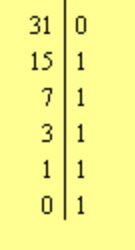
^^ if you look at this chart you'll see that they halve 125, but instead of using decimals, they have a remainder, and that remainder decides whether it is a 1 or a 0. isnt that interesting? this was being created in the early days of computing when basic calculations took a lot of design and thought.
so calculators, when doing big multiplications and such, will go through a series of simpler dividing and multiplying in twos, based off of the binary code assigned to the inputted factors.
like these examples

so unfortunately this means that in the wild west (im going for 1870's-90's) they sadly would not know what binary code is :((
still,, isnt this fascinating?? O____O
*holding gun up* isnnt is-isnt this fascinating O____O?
heres the sources btw: https://www.cs.cas.cz/portal/AlgoMath/NumberTheory/Arithmetics/NumeralSystems/PositionalNumeralSystems/BinarySystem.htm#:~:text=The%20modern%20binary%20number%20system,used%20symbols%200%20and%201.
[3] �Glaser, A. (1981). History of binary and other nondecimal numeration (Rev. ed.). Los Angeles: Tomash Publishers.
#i am a math nerd and im not taking math classes this semester so I AM DEPRIVED OK#also i just realized i took new adhd meds today and they are working a little too well#send help it is 2am i have class at 9:30#qsmp#qsmp federation#qsmp code monster#analysis#cw math#ig lmao#mushroom screams
18 notes
·
View notes
Text
Helen Popova Alderson
Helen Popova Alderson was a Soviet and British mathematician and mathematics translator known for her research on quasigroups and on higher reciprocity laws.
In the theory of higher reciprocity laws, Alderson published necessary and sufficient conditions for 2 and 3 to be seventh powers, in modular arithmetic modulo a given prime number p. According to Smith (1976), "plain quasigroups were first studied by Helen Popova-Alderson, in a series of papers dating back to the early fifties". Smith cites in particular a posthumous paper and its references. In this context, a quasigroup is a mathematical structure consisting of a set of elements and a binary operation that does not necessarily obey the associative law, but where (like a group) this operation can be inverted. Being plain involves having only a finite number of elements and no non-trivial sub algebras.
As well as Russian, English, and French, Alderson spoke Polish, Czech, and some German. She became the English translator of Elementary Number Theory, a textbook originally published in Russian in 1937 by B. A. Venkov. Her translation was published by Wolters-Noordhoff of Groningen in 1970. As well as the original text, it includes footnotes by Alderson updating the material with new developments in number theory
Quasigroup
Reciprocity law
Modular arithmetic
Binary operation
Associative property
11 notes
·
View notes
Text
Things I did/experienced this year
So every year I have this thing where I write down everything I did in the past year just to give myself a more positive outlook on things (and also for memory) and I decided I'll do it on here from now on. The first bit will be so school focused because I spend so much time at school.
Went back to college full-time
Won several scholarships
Was invited as a speaker to several events, including a Psych Department panel where all the other speakers were professors
Got accepted into a program at NASA (!!)
Got to use a big telescope and see Jupiter's and Saturn's moons and a few cool nebulae and binary star systems
Participated in an international student debate on neuroethics
Took several professional development courses (I'm psychological first aid and sui prevention certified, among other things)
Got very involved in campus events, student organizations, and volunteer work. Have 3 leadership positions in them
Actually made significant changes for students after speaking with the chancellor a few times on healthcare access and resources
Didn't back off of an issue and got my records fixed from years ago
Put together and arranged a TDOR event that involved local activists speaking on good community solutions for increasing safety, and managed to read the names list for this year without having a breakdown on stage
One of the projects I do got mentioned in the European Journal of Psychotraumatology this year
Stood up for my friends and a community I was in charge of
Maintained my boundaries
I guess I am conducting independent survey research lol. It's really small but whatever
Made more friends, maintained existing friendships
Opened up to others more
Made a lot of progress in therapy
Came to terms with a good chunk of my trauma
This year is the first year I have not had any recontact attempts or attempts at triggering me
Made a LinkedIn and a website, which is huge for me since like...name and face
Tutored my little brother on math since he has never been to school before or been taught any math (other than when I was raising him and taught him basic arithmetic, before I left) and just started public school this year! He's getting mostly As and Bs and one C (A in math!)
Started reading fiction again for the first time in years, around half of the books I read this year were fiction!
Started being able to read DID memoirs without needing to take several months off every 2 pages
Met my book reading goal for the year
Got a basic wardrobe so now I look like a person
Got more piercings, and got baby's first non-stick n poke tattoo
Got new healthcare professionals for the ones I wasn't satisfied with
Got hearing aids
Started using my mobility aids more instead of ignoring my needs
Started phys therapy specifically to get me to build up walking endurance for when I transfer to a big campus
Did my nails for the first time this year (just dollar store pressons), planning to learn how to do nail sets myself >:3
Hacked my 3DS finally after so many years
Started playing an MMO after many years of avoiding any game with Other People in it, and had fun
Went to a pride event specifically for POC :)
Did a fountain pen ink sample exchange with someone!
Got a fountain pen that I ADORE and it was 70% off
Realized I am actually very cute 😌
Got to try many new foods this year
One of the abusers is facing a huge lawsuit with over 50 different people testifying so maybe in a few years there will be...some kind of relief
23 notes
·
View notes
Text
Computer scientists scare me sometimes. This is a cool article though; basically, when computers process decimals, or "floating-point numbers,"* every number has its sign stored as a binary value: either positive or negative.
Mathematically, 0 is generally considered to be neither positive or negative, but floating-point computer software has a concept of "negative zero" and "positive zero." The article uses the weird (but precisely specified by a standard!) behavior of subtracting the two different zeroes to implement logic gates, and with them all of arithmetic.
*I think floating-point numbers are one of multiple ways computers can process decimals, but they're what the article is about.
2 notes
·
View notes
Text

I got most of the base of the CPU worked out on my NES emulator using references to 6502 Assembly and Rust binary arithmetic to implement the 6502 Op Codes. It was hard because originally I didn't update the flags and define the op code functions in the right place because the documentation I was following basically didn't provide the info on where to put it >_> But I wrote my tests at the bottom and in the main.rs file I defined a function that if everything passed on the CPU it would print out "Hello Rusty NES" to show me it works!
Today I am going to work a little on RAM management but @emoryvalentine14 and I are going to kill some Roblox zombies soon so it will be after while :D
It's going to be a while before the NES emulator is going to be live but I plan to host it on itch.io for 2.99$ along with some NES games I am personally deving in pure 6502 Assembly :| because I am a glutton for punishment.
Also the Discord is now at 70+ members and we are still a very positive community! Loving it. If you want to join shoot me a comment or a message!
Alright folks, I am going to sign off! Will update next update on the NES.
#Nes emulator#emulator#NES#Nintendo#Nintendo Entertainment System#Nintendo SNES#Super Nintendo#game emulator#gaming#rust programming#rust language#rust lang#rust programmer#systems development#technology#programming#programmer#programmers#development#developer
7 notes
·
View notes
Text

tagged by. @ruinlost - thank you!
tagging. @caduceuss @dottoray @drolliic @shameofice @za-baransu @narvvhal @frcstwinded @yingda @ancientforged @abyssmalice - pls ignore if you've already been tagged! and if you'd like to steal this, feel free to say i tagged you!

𝐛𝐚𝐬𝐢𝐜𝐬.
name. bai zhiyuan / pantalone / the regrator
age. 40s
birthdate. jan 1st
species. human
gender. non-binary / masc (he/they)
orientation. unsure, on the aromantic spectrum somewhere but takes an active interest in sex, and intimacy on very select occasions.
profession. 9th of the fatui harbingers ( glorified accountant / shady banker )
𝐩𝐡𝐲𝐬𝐢𝐜𝐚𝐥 𝐚𝐬𝐩𝐞𝐜𝐭𝐬.
hair. inky blue-black with volume and a slight wave, sits just at his shoulders and frames his face. flecks of silver from use of a delusion.
eyes. crimson, slightly shadowed and lightless.
skin. pale, warm undertone.
height. 6ft, occasionally wears slight heel to be 6ft 2in. he likes towering over others.
weight. 160lbs - 170lbs; he is quite slim for his height
𝐟𝐚𝐦𝐢𝐥𝐲.
siblings. brother.
parents. deceased, or otherwise written out of his life.
grandparents. unknown to him.
other relatives. unknown to him.
pets. no pets.
partners. no '''''''partner'''''' to speak of (on paper). pantalone makes his moves in private, and you should stay out of his business.
𝐬𝐤𝐢𝐥𝐥𝐬.
economics. turns water into wine, so to speak. if there is money to be made then the regrator has already made it, tenfold.
public speaking. eloquent and persuasive, the ever-perfect diplomat.
strategist. the regrator is always several step ahead of any adversaries.
mathematics. similar to economics, but he is also exceptional at mathematics in general. great at mental arithmetic.
𝐥𝐢𝐤𝐞𝐬.
colors. black, blue, white, occassionally purples, silvers.
smells. glaze lily perfume, street food in a busy market, salt water,
textures. feathers, furs, plush fabrics, velvets and satins. he does not want uncomfortable, hard or cheap materials.
drinks. mondstadt wines, reluctantly fond of neat 'fire water', complex flavoured water for no reason other than 'just because'.
𝐨𝐭𝐡𝐞𝐫 𝐝𝐞𝐭𝐚𝐢𝐥𝐬.
smokes. yes; tobacco in a long pipe.
drugs. no hard drugs, alcohol at most.
driver license. can ride a horse to a reasonable standard (but would much rather be ferried around). has a glider, does not use it.
ever been arrested. they could never catch him <3
#✧ : FILED. headcanon.#the formatting kept breaking when writing this so if it looks weird just look the other way
13 notes
·
View notes